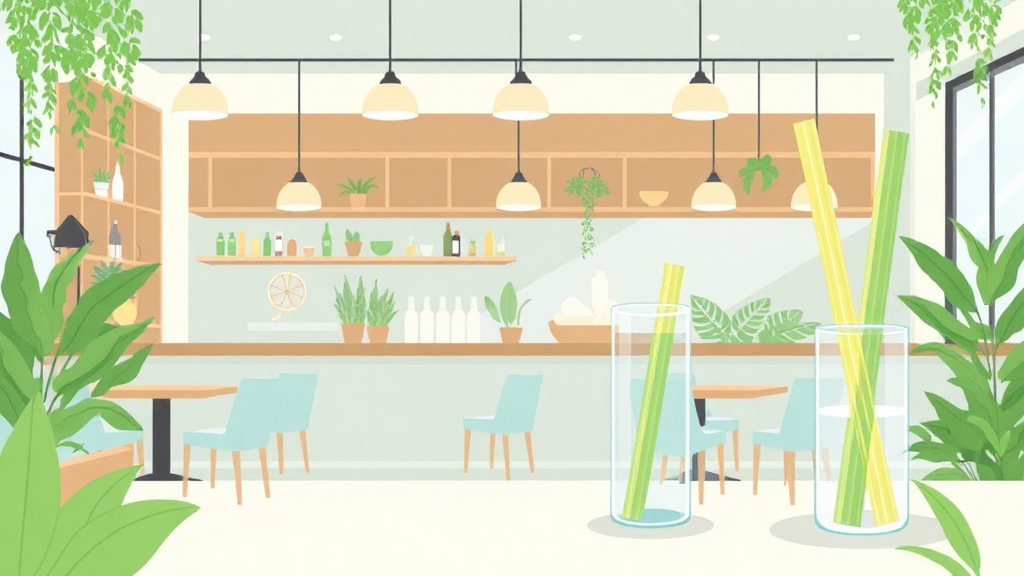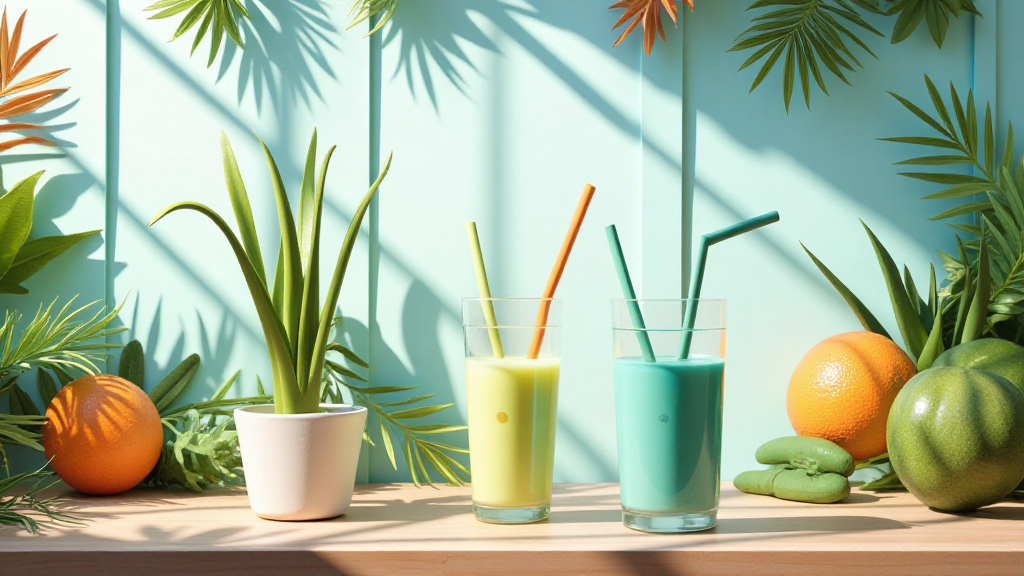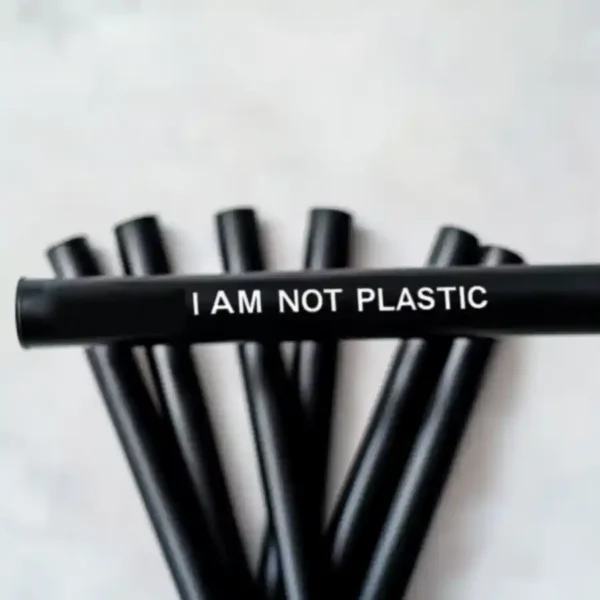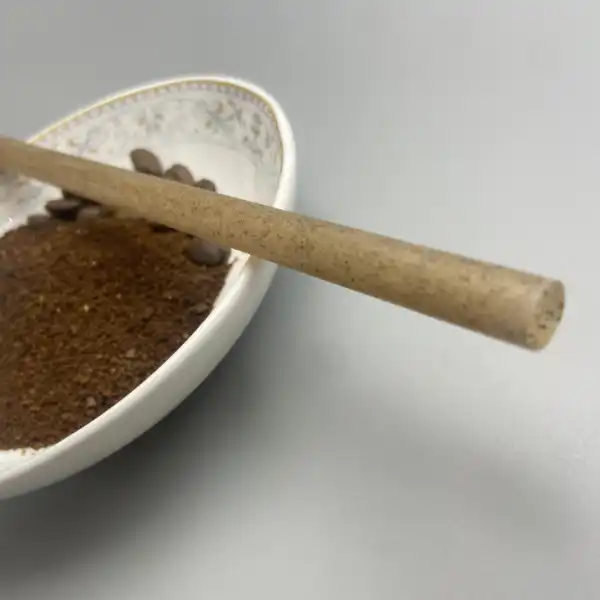
As global awareness of plastic pollution intensifies, businesses and consumers increasingly demand sustainable alternatives to single-use plastic straws. Traditional plastic straws persist in the environment for centuries, leaching microplastics and harming marine ecosystems. Biodegradable materials such as sugarcane bagasse, bamboo, plant-based polymers (like PLA and PHA), and paper offer compelling alternatives, balancing durability, cost-effectiveness, and environmental responsibility. This article examines emerging trends in eco-friendly straws, highlighting their advantages over conventional plastic and providing actionable insights for businesses seeking to adopt sustainable practices.
Drivers of Change: The Rise of Biodegradable Sugarcane Straws
Environmental Regulations and Consumer Demand
Governments worldwide are enacting legislation to curb single-use plastic pollution. Rwanda, Canada, and Kenya have completely banned plastic straws. These bans, coupled with growing consumer preference for sustainable brands (67% of consumers prioritize sustainability), are driving the adoption of biodegradable alternatives. Starbucks Japan’s commitment to transitioning to PHBH straws (a vegetable oil-derived material that decomposes into CO2 and water) by 2025 exemplifies this shift. Restaurants and businesses embracing compostable or marine-degradable straws not only meet regulatory requirements but also attract environmentally conscious customers, enhancing brand image and potentially increasing customer loyalty.
Comparing Biodegradable Straw Materials: A Detailed Analysis
The choice of biodegradable straw material involves careful consideration of various factors. Here’s a comparative analysis of popular options:
| مواد | Pros | Cons | Cost Estimate (USD/straw) | Decomposition Conditions | Additional Considerations |
|---|---|---|---|---|---|
| Sugarcane Bagasse | Durable, marine-degradable, low carbon footprint, relatively inexpensive. | May not be suitable for all beverages; potential for breakage. | $0.02 – $0.05 | Composting facilities or marine environment. | Source responsibly to ensure sustainability. |

Material Options for Sustainable Packaging
Material Overview
| مواد | Pros | Cons | لاگت | Composting Options | نوٹس |
|---|---|---|---|---|---|
| Bagasse | Renewable resource, biodegradable, compostable. | Limited color and style options. | $0.05 – $0.08 | Industrial composting, marine | Sourcing is crucial for sustainability. |
Biodegradable Straw Materials: A Comparison
| مواد | Pros | Cons | Cost per 1000 | Disposal Method | Additional Notes |
|---|---|---|---|---|---|
| Bagasse (Sugarcane) | Sustainably certified bagasse is crucial for environmental benefits. Biodegradable, compostable, renewable resource. | May not be suitable for all beverages; durability can vary. | $0.05 – $0.08 | Home composting, industrial composting | Source sustainably certified bagasse for optimal environmental impact. |
| PHA (Polyhydroxyalkanoate) | Decomposes in soil and seawater; similar feel and performance to plastic. | Higher cost; limited availability compared to other options. | $0.11 – $0.15 | Industrial composting, soil, seawater | A promising biodegradable plastic alternative, but cost remains a barrier to widespread adoption. |
| کاغذ | Affordable; widely available; readily compostable. | Soggy in drinks; lacks durability; not suitable for all beverages. | $0.04 – $0.06 | Home composting, industrial composting | Consider using a food-safe coating to improve durability and water resistance. |
| بانس | Reusable (up to 6 months); chemical-free; aesthetically pleasing. | Requires frequent cleaning and sanitization; potential for splintering. | $0.10 – $0.15 | Not applicable (reusable) | Requires proper cleaning protocols to maintain hygiene and longevity. A sustainable alternative to single-use plastic straws. |
| PLA (Polylactic Acid) | Compostable in industrial facilities; renewable resource (corn starch or sugarcane). | Not suitable for home composting; may not fully degrade in all environments. A biodegradable plastic option made from renewable resources. | $0.06 – $0.09 | Industrial composting |

Sugarcane Straws: A Superior Sustainable Solution
Sugarcane bagasse, a readily available byproduct of sugar production, is rapidly becoming a leading sustainable alternative to plastic straws. Its advantages are compelling:
- Exceptional Durability: Maintains structural integrity in both hot and cold beverages for up to 12 hours, providing a user experience comparable to traditional plastic straws. This extended lifespan reduces the overall consumption and waste generated. For example, KonzaWare’s sugarcane straws successfully maintain their form and function throughout this period, demonstrating the material’s robust nature.
- Marine-Friendly Biodegradability: Completely breaks down in seawater within 90 days, leaving behind no microplastic residue. This significantly mitigates the environmental impact on marine ecosystems, a critical consideration given the vast quantities of plastic straws polluting our oceans.
- Cost-Competitive Pricing: Bulk pricing starts as low as $0.04 per straw, making it a financially viable alternative to both plastic and even paper straws. This affordability removes a significant barrier to adoption for businesses of all sizes.

The shift to biodegradable sugarcane straws offers a compelling solution for businesses seeking eco-friendly alternatives to traditional plastic straws. These straws provide a durable, cost-effective, and environmentally responsible option, contributing to a more sustainable future.
Factors Driving the Adoption of Biodegradable Sugarcane Straws
- Bulk purchasing of sugarcane straws can reduce costs by 30%, making them increasingly competitive for businesses with high consumption rates.
- Government incentives and subsidies, such as those offered through the EU Circular Economy grants, are further accelerating adoption by providing financial support for businesses transitioning to sustainable alternatives.
Distribution networks are also expanding rapidly, ensuring accessibility for businesses worldwide:
- Global retailers like Green Paper Products offer a wide range of compostable straws, including sugarcane, providing convenient access for businesses of all sizes.
- Direct-to-business platforms like ShopEquo offer bulk discounts for restaurants and other food service businesses, streamlining procurement and reducing costs.

Actionable Steps for Businesses Transitioning to Biodegradable Sugarcane Straws
- Conduct a Thorough Usage Audit: Accurately calculate daily and weekly straw consumption to establish a realistic budget and procurement plan. This will inform purchasing decisions and ensure efficient inventory management.
- Test a Variety of Biodegradable Materials: Experiment with different biodegradable options, such as sugarcane for everyday use and PHA for high-end establishments requiring superior durability and aesthetics. This allows you to select the most suitable option based on your specific needs and budget.
- Educate Your Customers: Use clear and informative signage to communicate the environmental benefits of your sustainable straw choice. Phrases like “This straw helps protect our oceans” or “Made from 100% renewable sugarcane” can resonate with environmentally conscious consumers.
- Collaborate with Environmental NGOs: Partner with organizations focused on ocean conservation to amplify your sustainability message and contribute to meaningful environmental initiatives. WinCup’s phade® program, which supports coral reef restoration, offers a compelling example of such partnerships.
اکثر پوچھے گئے سوالات (عمومی سوالنامہ)
Comparing Biodegradable Straw Materials: A Detailed Analysis
Choosing the right biodegradable straw material requires careful consideration of various factors. The following table compares prominent options, highlighting their strengths and weaknesses:
| مواد | Pros | Cons | Cost (USD/straw) | Example Use Cases |
|---|---|---|---|---|
| PLA (Polylactic Acid) | Heat-resistant, suitable for coffee and tea. | Can be brittle; not always compostable at home. | $0.06 – $0.10 | Coffee shops, cafes |
| بانس | Natural and biodegradable, but not recommended for extremely hot beverages. | Can be less durable than other options; may require more processing. | $0.04 – $0.07 | Juice bars, restaurants |
| Sugarcane Bagasse | Durable, marine-degradable, low carbon footprint, readily compostable. | May not be suitable for all beverages; can absorb liquids. | $0.05 – $0.08 | Restaurants, bars |
Claim Your Free Samples Today!
Ready to make a positive impact on the environment and enhance your business’s sustainability profile? نیچر بائیو ایکو offers free sugarcane straw samples to businesses—no obligation! Experience firsthand the durability and performance of these eco-friendly alternatives.

| مواد | Properties | Price Range | Ideal Customer |
|---|---|---|---|
| گنے | Biodegradable, compostable, made from a renewable resource. A sustainable alternative to plastic straws. | $0.08 – $0.10 | Restaurants, cafes, juice bars seeking a durable, environmentally friendly option. |
| PHA (Polyhydroxyalkanoate) | Decomposes in soil and seawater, closely resembles plastic in feel and performance. A high-performance biodegradable straw option. | $0.10 – $0.12 | High-end restaurants, events, or situations requiring a premium, high-performance straw. |
| کاغذ | Affordable, widely available, easily compostable. An economical biodegradable straw choice. | $0.04 – $0.06 | Fast-food chains, casual dining establishments where cost is a primary concern. |
| بانس | Reusable (up to 6 months with proper care), chemical-free, aesthetically pleasing. A sustainable and reusable straw alternative. |

| PLA (Polylactic Acid) | Heat-resistant, FDA-approved | Requires industrial composting |
| Sugarcane Bagasse | Durable (maintains structural integrity in hot/cold beverages for up to 12 hours), marine-safe (breaks down in seawater within 90 days without microplastic residue), cost-effective (bulk pricing starts at $0.04 per straw) | Requires specific composting conditions |
Sugarcane Straws: A Sustainable and Economical Biodegradable Alternative
Sugarcane bagasse, a readily available byproduct of sugar production, is rapidly gaining traction as a superior alternative to traditional plastic and even PLA straws. Its unique properties offer a compelling solution for businesses seeking eco-friendly and cost-effective options.
Key Advantages of Biodegradable Sugarcane Straws:
1. Exceptional Durability:
Unlike paper straws that often become soggy, sugarcane straws maintain their structural integrity in both hot and cold beverages for up to 12 hours. This extended usability enhances the customer experience and reduces waste associated with prematurely discarded straws. For example, independent testing demonstrated a 12-hour structural integrity in both iced coffee and hot tea.
Environmental Benefits of Sugarcane Straws
Sugarcane straws are fully biodegradable and compostable. Their decomposition in seawater within 90 days eliminates the persistent microplastic pollution associated with traditional plastic straws. This aligns perfectly with growing consumer and regulatory concern regarding marine pollution. Furthermore, home composting is possible, though it may require longer decomposition times (approximately 180 days, as demonstrated by KonzaWare’s sugarcane straws). This offers a more accessible composting solution compared to PLA straws, which typically require industrial composting facilities.
Cost-Effectiveness of Sugarcane Straws
With bulk pricing starting at just $0.04 per straw, sugarcane straws present a highly competitive alternative to both paper and plastic straws. This affordability makes them a financially viable option for businesses of all sizes, allowing them to adopt sustainable practices without significantly increasing operational costs. A direct cost comparison against your current straw supplier will likely reveal substantial savings over time.
KonzaWare’s sugarcane straws serve as a prime example of this material’s potential. Their 180-day home compostability, coupled with a user experience comparable to traditional plastic straws, showcases the successful integration of sustainability and practicality.
Market Growth and Industry Adoption: A Booming Opportunity for Biodegradable Straws
The global eco-friendly straw market is experiencing explosive growth, projected to reach a staggering $22 billion by 2033, up from $10 billion in 2023, representing a compound annual growth rate (CAGR) of 12.2% through 2029. This significant expansion is fueled by several key factors:
- Increased Demand from Hospitality: The hospitality sector, particularly in rapidly developing economies like China and India, is driving substantial growth, with a projected CAGR of 14%. This reflects a growing awareness of environmental responsibility within the
Market Drivers for Biodegradable Sugarcane Straws
- Growing Environmental Concerns: The increasing awareness of plastic pollution and its detrimental effects on the environment is driving a global shift towards biodegradable alternatives, creating a significant market for sugarcane straws and other eco-friendly products within the food and beverage industry and a corresponding demand for sustainable alternatives.
- Corporate Sustainability Pledges: A rising number of corporations are incorporating sustainability initiatives into their business strategies, leading to increased demand for eco-friendly products like sugarcane straws. These pledges often include specific targets for reducing plastic waste, creating a strong market pull for sustainable alternatives.
- Consumer Preference Shift: Consumers are increasingly conscious of their environmental impact and actively seek out sustainable products. This shift in consumer preference is creating a significant market opportunity for businesses offering eco-friendly alternatives, such as biodegradable sugarcane straws.
Strategies for Capitalizing on Biodegradable Straw Market Growth
To capitalize on this market growth, businesses should consider:
- Supplier Diversification: Explore multiple sugarcane straw suppliers to ensure consistent supply and competitive pricing.
- Strategic Partnerships: Collaborate with industry leaders and sustainability organizations to enhance brand reputation and market reach.
- Marketing & Communication: Highlight the sustainability benefits of sugarcane straws in marketing materials to attract environmentally conscious consumers. Emphasize the biodegradable nature of the straws and their positive impact on reducing plastic waste.
By strategically leveraging the growing demand for sustainable solutions, businesses can position themselves for success within this rapidly expanding market. The transition to sugarcane straws represents not just a cost-effective solution but also a significant step towards a more environmentally responsible future.

Frequently Asked Questions About Sugarcane Straws
Q: What are the benefits of using biodegradable sugarcane straws?
Biodegradable sugarcane straws offer several advantages, including their durability, marine-degradability, low carbon footprint, and relatively low cost. They are a sustainable alternative to traditional plastic straws, helping to reduce plastic pollution.
Q: What are the best biodegradable straw options for my business?
The ideal biodegradable straw depends on your budget and needs. Bagasse offers a cost-effective and readily compostable solution, while PHA provides a more durable, plastic-like alternative. Paper straws are affordable but less durable. Bamboo straws are reusable, reducing waste.
Q: How do I dispose of biodegradable straws responsibly?
Check the specific disposal instructions for each material. Many biodegradable straws are compostable in industrial facilities, while some can be composted at home. Always follow local recycling guidelines.
Q: How durable are sugarcane straws?
Sugarcane straws maintain their structural integrity in both hot and cold beverages for up to 12 hours, offering a user experience comparable to plastic straws.
Q: How long do sugarcane straws take to biodegrade?
Sugarcane straws completely break down in seawater within 90 days, leaving no microplastic residue.
Q: How long do biodegradable straws take to decompose?
A: Decomposition time varies depending on the material and composting conditions. Marine-degradable PHA typically breaks down within 3-6 months, while sugarcane straws decompose in approximately 6 months under optimal composting conditions. Industrial composting is often required for optimal decomposition rates.
Q: Are compostable straws safe for hot drinks?
A: Sugarcane straws are generally safe for hot drinks up to a certain temperature. Always check the manufacturer’s recommendations for safe usage.
Q: Can I order small quantities of sustainable straws?
A: Yes, many retailers, such as GreenPrint, offer smaller sample orders, often starting around 200 units, allowing businesses to test the product before committing to larger orders.
Q: Do biodegradable straws cost more than plastic straws?
A: Currently, biodegradable options are approximately 20% more expensive than plastic. However, this added cost is often offset by increased customer loyalty, improved brand image, and potential savings from regulatory compliance.
Q: What are the benefits of switching to biodegradable straws?
Switching to biodegradable straws offers numerous benefits, including enhanced brand reputation, increased customer loyalty, and a reduced environmental footprint. It demonstrates a commitment to sustainability.
Q: What factors should I consider when choosing a biodegradable straw material?
Consider factors such as cost, durability, performance, and compatibility with your brand image and target market. Think about the disposal infrastructure in your area as well.
Q: How can I communicate my commitment to using biodegradable straws?
Clearly communicate your switch to biodegradable straws through marketing materials, in-store signage, and on your website. Highlight the environmental benefits of your choice.








